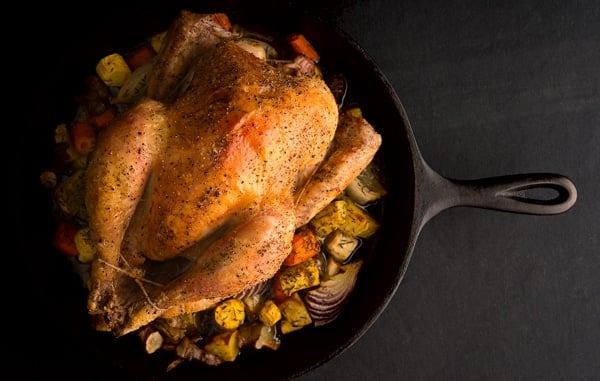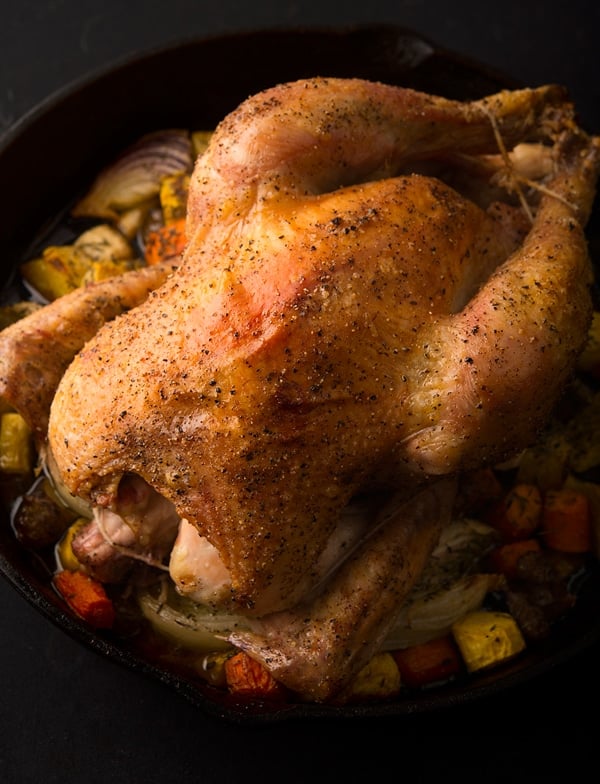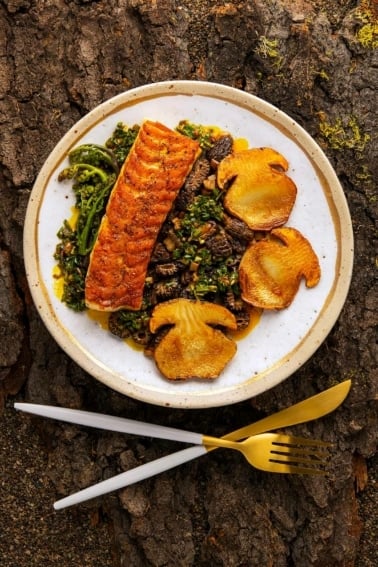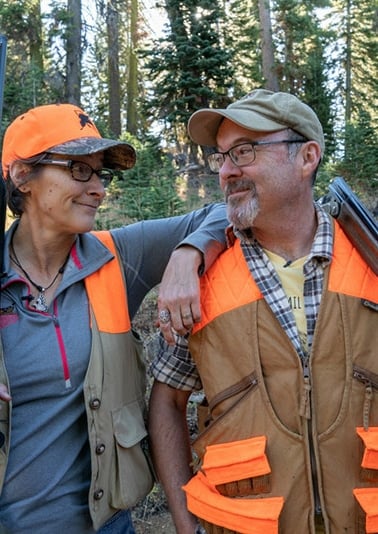As an Amazon Associate I earn from qualifying purchases.

I bought a chicken the other day. To virtually every other American, this is an event akin to taking out the trash, or driving to work — a commonplace barely worth noting. But there’s something you should know: I have not bought meat for the home more than a handful of times over the past decade. So buying any meat is very much an event for me. You might ask why on earth, of all the things that I could have chosen to break my self-imposed fast on domesticated meats, would I buy a chicken?
Because of all the flavors I miss from the store-bought world — ribeyes, skirt steak, a huge pork chop, shrimp — chicken is the one I long for most often. Chicken. You read that right. Chicken deserves respect. It deserves to be reclaimed by the culinary world for what it has been for most of human history: A bird worthy of a king’s table, a gift for cooks to work magic on. A platter of home.
How Americans came to believe that $1 a pound chicken is as inalienable a right as free speech or the right to bear arms is a depressing story of industrial might over right. Suffice to say that when Frank Perdue said it took a tough man to make a tender chicken, he was right. He and his colleague John Tyson needed to be OK with debasing a once prized bird, to polluting environments and destroying whole communities. The industrial chicken is a wretched shadow of its former self. To paraphrase J.R.R. Tolkien: “they were chickens once… tortured, and mutilated… a ruined and terrible form of life…now perfected.”
The modern chicken has a breast so big it can barely walk or fly. It’s lethargic, to the point where even if a farmer gives it pasture to roam it won’t. It grows with frightening speed: In 1960 it took about 5 months to raise a meat chicken for market. Now it can be done in 6 weeks. In 1925, a chicken needed to eat 4.7 pounds of feed to gain 1 pound. Now it only needs to eat 1.9 pounds of feed to gain the same pound. Only tilapia, the Soylent Green of fish, has a better feed ratio.
This is the chicken you eat. And we Americans eat a lot of it. Chicken topped beef as America’s favorite meat in 1992. In 2006 we ate an average of 87.7 pounds of these birds, the highest poundage on record. And as you well know, we are not eating all this chicken as a whole bird.
Various shreds of it are glued together to make your McNugget. It’s injected with a saline solution to “plump” it and make the watery, flabby, tasteless meat even more tender; apparently teeth are no longer needed to enjoy your skinless, boneless chicken lump. it’s sliced and diced in so many ways that the concept of roasting a whole chicken — once a bedrock skill every cook possessed — is now so daunting it’s a challenge on Top Chef. (Incidentally, chicken used to be almost always sold whole, with the head and feet on, right up into the 1950s. Why? Consumers judged chickens like fish: Are the eyes clear? Feet fresh looking? People knew what a good chicken looked like. Now if you did that you’d create an incident, unless you are at an Asian market. )
No wonder the average consumer recoils in horror at the notion of $5 a pound chicken. Chicken has become our baseline, our lowest common denominator of meat. It’s our daily bread, a right like free bread in ancient Rome or free gas in modern Saudi Arabia.
This, you should know, is a fairly recent state of affairs. By rights, chicken should indeed cost about $5 a pound. If you recall your high school history or are very old, you will remember President Herbert Hoover promising “a chicken in every pot” should we elect him to the Oval Office. Modern readers of that quote are mystified. A chicken in every pot? So what?
Well, as it happens, a chicken was a big deal in 1928, when Hoover spoke those words. If you adjust for inflation, a chicken cost about $5.85 a pound in 1928, down from about $8.23 a pound in 1923, when Delaware farmers first started shipping live chickens to New York City to serve the Jewish market. Incidentally, in those days a beef rib roast cost about $5.24 a pound, in today’s dollars.
Flash forward to 1946. Chicken was — again, adjusted for inflation — $5 a pound. Ditto in 1960. Even as late as 1980, two decades after the “chicken revolution” had begun, the adjusted price for a whole broiler was $4.51. And mind you, that 1980 chicken was nearly as terrible as today’s. A series of industry “improvements,” slower rates of inflation and booming demand hammered the price down to its nadir, $1.04 a pound in 2004. Costs have risen mildly since then.
The industrial chicken is not going anywhere. It is part of our national fabric, and I am definitely not saying that the crappy chicken you buy at the nearest mega-mart should cost $5 a pound. That is indeed crazy. But it’s not the only chicken in town.
Not every farmer bought into the chicken revolution. Some farmers kept raising stouter, hardier breeds of birds the way they always had. Perhaps the biggest reason for my choice of a chicken is because I have vivid memories of astonishingly good chicken during my childhood. Thirty years ago, my mom, whose family raised chickens when she was a little girl, bought broilers from a place called Gage’s Chicken Farm in New Jersey. Real chickens. Big, strong, fat, yellow and plump. These were special occasion chickens, to be roasted whole, carcass made into soup.

There are many such farmers today. You’ve seen them at the farmer’s market. Some of them are my friends, including the folks at Dinner Bell Farms, where I bought this chicken. They have gleaned all the good from the modern chicken industry and applied it to decent husbandry of their meat chickens, producing a superior product. And, by and large, they charge between $4 and $9 a pound for their birds.
Mostly people understand that this is a weekend chicken, so things go smoothly. But a significant minority of shoppers heap derision on them for their prices. I don’t know a single small farmer who doesn’t have a horror story about customers giving them shit for charging even $3 a pound, let alone $9. (This story, from my friends Christian and Kate in Michigan, is especially good.) Fer chrissake, I once watched a woman happily pay $4 a pound for heirloom tomatoes walk over to the chicken vendor and give him a raft of crap for daring to sell chicken at $4.50 a pound. The disconnect would be amusing were it not so sad.
It’s worth repeating: The chickens you buy at the farmer’s market are not the same birds as you buy from even fancy supermarkets. They’re not even the same things as the Mary’s or other mass-market “organic,” free-range, whatever-whatever chickens you buy in the store. They are something entirely different. At worst, they are superior birds at the table. At best, they are downright magical.
Denser, meatier, fatter, and so much fuller in chicken flavor that one perfectly cooked bite will ruin you on the mass market dreck forever.
Yes, they are expensive. They are not for everyday meals, unless you are in the tax bracket to afford $30 chickens routinely. But consider this: Many of you will happily pay $30 a pound for wild-caught salmon. Or $9 a pound for a goose, or hell, even the $15 a pound for regular commodity ribeyes you get in the supermarket.
Chefs, you too are to blame. Most of you hate chicken, with good reason if you are talking about industrial birds. You shrug off chicken as trash meat, uninteresting, something you are forced to cook for the unwashed, civilian, tin-palate masses. What you really want to cook is pork. And not just any pork. So-called heritage breeds, the Berkshires, Durocs, Tamworths and such, are darlings in the culinary world. Well, there are just as many heritage breeds of chicken, too.
I hear ya. You’ll need to charge $30 an entree if you use good chickens. I get food costs. But restaurants are where change happens in food, and they are places where people have special occasions. If you can play up the farmer on your pork chop, you can for your chicken, too.
It will take time, and the continuing efforts of farmers like Molly Nakahara and Paul Glowaski of Dinner Bell Farm, to swing the pendulum. And it will also take you and me. Seek out a real chicken. Roast it whole. Make soup from the carcass. Use every bit. Revel in a plate of home.



